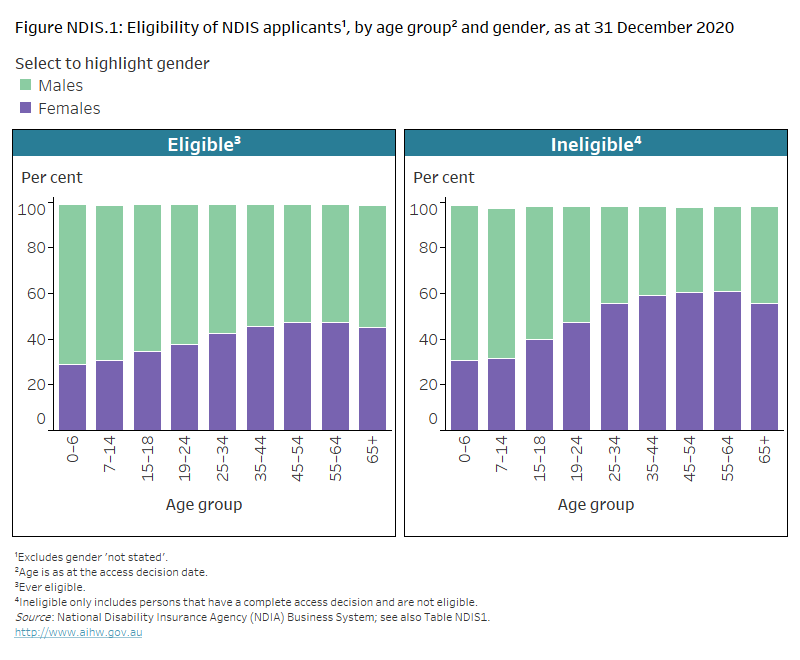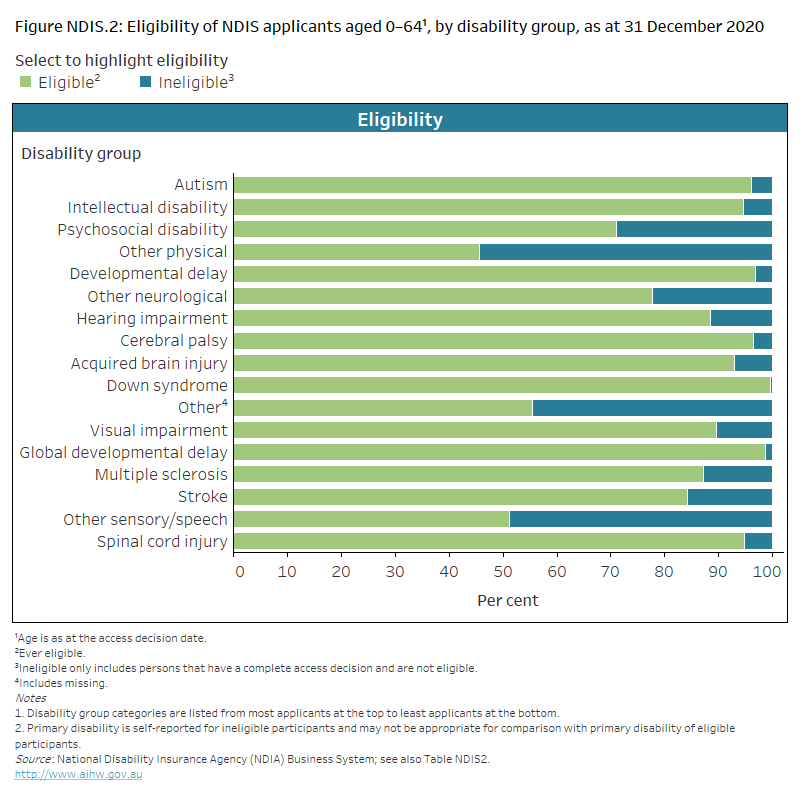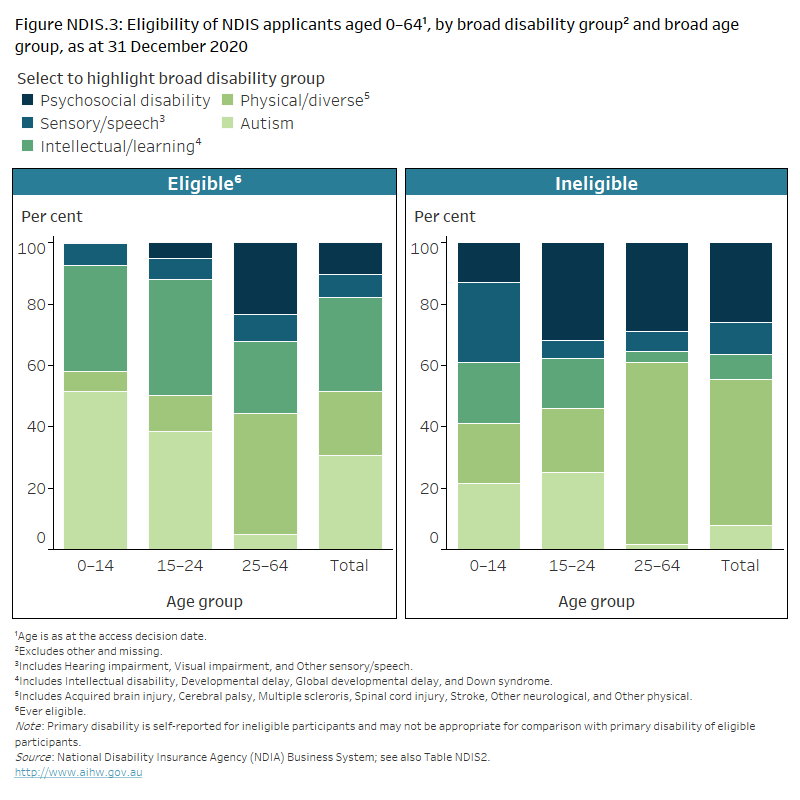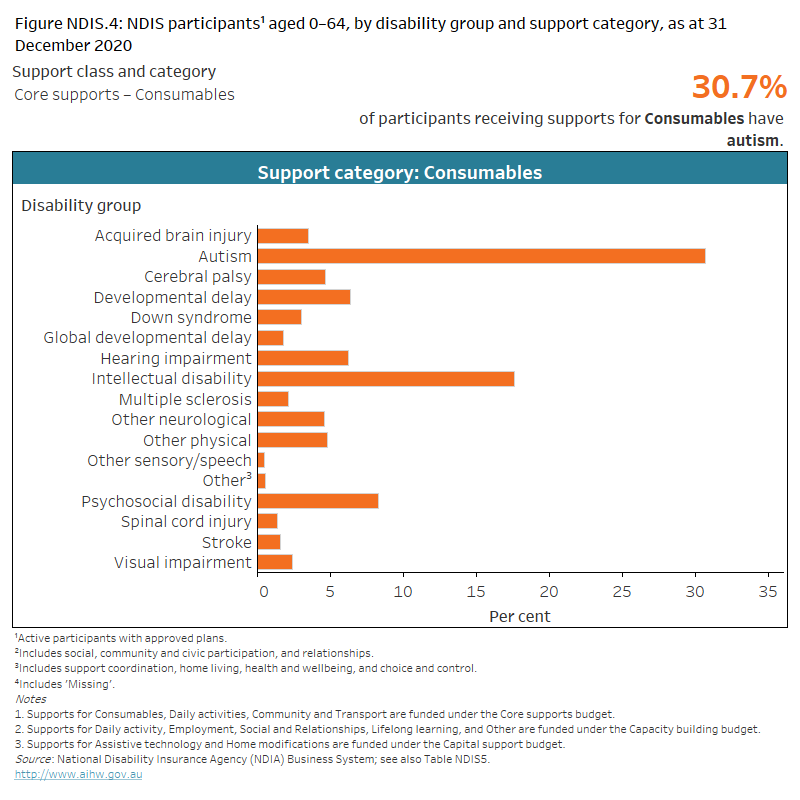Specialist disability support services
Around 519,000 people
were active participants in the National Disability Insurance Scheme (NDIS) at 31 March 2022
4 in 10
(41%) active NDIS participants are aged 14 and under
About 40%
(or 1.7 million) of people with disability need assistance from formal providers
On this page:
Introduction
People with disability who need support can use specialist disability services, mainstream services, and/or be supported by informal carers. They may also receive financial assistance to help with daily activities (see Income support for more information on financial assistance).
This section focuses on one part of this broader, and interacting, system of supports – specialist disability support services funded or provided by government.
Specialist disability support services are now largely provided through the National Disability Insurance Scheme (NDIS). Most, but not all, National Disability Agreement (NDA) services, and the people using them, have transitioned to the NDIS. For information on services provided under the NDA, please refer to the archived versions of this report.
In 2019–20, support was provided to people with disability under the NDIS and other disability-specific services. In that year, government expenditure on disability was $18.7 billion. This includes $16.0 billion provided to the NDIS; the remaining $2.7 billion in 2019–20 was for disability-specific services provided outside the NDIS (SCRGSP 2020, 2021).
This section provides information on:
- eligibility for and service provision in the NDIS
- met and unmet need for formal services (from the Australian Bureau of Statistics’ (ABS) Survey of Disability, Ageing and Carers (SDAC)).
What are specialist disability support services?
Specialist disability support services help people with disability participate fully in daily life. They may supplement other support a person receives, such as that provided by mainstream services, the community and/or informal carers.
Disability support services may include:
- assistive technology (for example, wheelchairs, hearing aids, voice-recognition computer software)
- case management
- early childhood intervention services
- life skills development
- specialist accommodation and home modifications
- support to live in the community (for example, personal care and domestic assistance)
- support to participate in community activities
- respite care
- employment services.
Specialist disability support services are primarily aimed at people aged under 65, but support is also available to eligible people aged 65 and over.
Support provided through the National Disability Insurance Scheme
The NDIS is designed to provide Australians with permanent and significant disability with the reasonable and necessary support needed to participate in everyday life.
About the National Disability Insurance Scheme
The NDIS is a fundamental shift in the way Australians with significant and permanent disability access supports. It is founded in insurance principles to provide eligible Australians who have a permanent and significant disability, with the reasonable and necessary supports they need (NDIA 2020a).
The NDIS was introduced in trial sites in 2013, and has been progressively rolled out across Australia from July 2016. From 1 July 2020, the NDIS has been made available to all eligible Australians, no matter where they live (NDIA 2020b). The National Disability Insurance Agency (NDIA) estimates that, by 30 June 2025, the NDIS will provide around 670,000 Australians (634,000 aged under 65) with funding for supports and services (NDIA 2021a). People with disability are directly funded under the NDIS, as distinct from the previous system of block funding to agencies and community organisations that provided disability support services under the National Disability Agreement (NDIA 2020a).
National Disability Insurance Agency
Data in this section are largely sourced from the National Disability Insurance Agency (NDIA). Any data not referenced on this page are sourced from Data tables for this report.
Active participants
At 31 March 2022, there were around 519,000 active NDIS participants with approved plans (with an additional 11,200 children supported by the early childhood approach) (NDIA 2022).
Of active NDIS participants as at 31 March 2022:
- 4 in 10 (41% or 215,000) were aged 14 or under
- more than 3 in 5 (62% or 319,000) were male (excluding gender stated as ‘other’)
- 8.7% (or 37,300) identified as Aboriginal and/or Torres Strait Islander (excluding 88,600 with Indigenous status not stated)
- 79% lived in major cities or towns with population over 50,000, and 8.0% lived in towns with population below 5,000 or in remote or very remote areas
- the most common disability groups were autism (34%), intellectual disability (18%, including those with Down syndrome) and psychosocial disability (11%)
- 26% had a low level of function, 46% had a medium level of function and 28% had a high level of function, in terms of level of disability
- 2,700 were younger people in residential aged care (aged under 65) (NDIA 2022).
See NDIS quarterly reports for the latest data.
How is remoteness defined?
The remoteness categories used in this section are based on the Modified Monash Model 2019 which classifies locations into 7 categories from major cities to very remote (NDIA 2022). The classifications are based on the ABS Australian Statistical Geography Standard – Remoteness Areas framework and utilise Census data. For more information see Modified Monash Model.
Eligibility
At 31 December 2020, 85% (or 469,000) of applicants to the NDIS were ever eligible for access (NDIA 2021b).
What does ever eligible mean?
Ever eligible is a count of people who have ever gained access to the NDIS. It includes people who have now had their access ceased or revoked. Access can be ceased or revoked for a number of reasons including: death, no longer meeting the scheme’s eligibility criteria, or self-elected exit.
This section reports on variations in eligibility for NDIS supports across various population groups. While there may be multiple possible reasons behind these differences, this report does not attribute these differences to any particular reason, nor does it make any inferences about causation.
Eligibility varies by age and gender. At 31 December 2020, around half (52% or 245,000) of applicants who were ever eligible are aged 18 and under:
- 26% (or 122,000) aged 6 and under
- 19% (or 91,500) aged 7–14
- 6.8% (or 31,700) aged 15–18 (NDIA 2021b).
The majority of eligible applicants were males, although the proportion of females increased with age:
- 70% (or 148,000) aged 14 and under (excluding gender ‘not stated’) of those ever eligible were males
- 52% (or 32,200) aged 55–64 were males (Figure NDIS.1) (NDIA 2021b).
Figure NDIS.1: Eligibility of NDIS applicants, by age group and gender, as at 31 December 2020
Stacked column chart showing the proportion of NDIS applicants who are males and females that are ever eligible or ineligible by age groupings 0–6, 7–14, 15–18, 19–24 then 10-year age groupings from 25–34 to 55–64 then 65 and over. The chart shows 68% of ineligible applicants aged 0–6 are males compared to 37% of those aged 55–64.

Source data tables: NDIS (XLSX, 410 kB)
Eligibility does not vary substantially by whether the applicant lives in an urban or remote location; for example, of those aged 64 and under (where remoteness is known):
- 86% (or 366,000) of applicants living in a major city or a population centre with more than 50,000 inhabitants were ever eligible
- 85% (or 62,400) of those living in towns with population between 5,000 and 50,000
- 83% (or 37,700) of those living in towns with population less than 5,000, or in remote and very remote areas (NDIA 2021b).
Eligibility does not vary by Indigenous status, however it does vary for culturally and linguistically diverse (CALD) groups (where CALD status is known):
- 80% (43,500) of applicants aged 64 and under who were from culturally and linguistically diverse backgrounds (born in a non-English speaking country and/or primarily spoke a language other than English at home) were ever eligible
- 86% (414,000) of those who did not belong to the CALD cohort (NDIA 2021b).
Eligibility also varies by disability group; for example, of those aged 64 and under:
- 96% (or 142,000) of applicants with autism were ever eligible
- 95% (or 81,200) of applicants with intellectual disability were ever eligible
- 71% (or 47,300) of applicants with psychosocial disability were ever eligible (Figure NDIS.2) (NDIA 2021b).
Figure NDIS.2: Eligibility of NDIS applicants aged 0–64, by disability group, as at 31 December 2020
Stacked bar chart showing the proportion of NDIS applicants aged 0–64 who are ever eligible or ineligible by 17 disability groups. The disability groups are listed from most applicants (autism) to least applicants (spinal cord injury). The chart shows, among the 5 disability groups with most applicants, 96% of applicants with autism are ever eligible compared to 46% with other physical disability.

Source data tables: NDIS (XLSX, 410 kB)
Differences in eligibility are also evident among disability groups by age group. For example:
- 51% of applicants aged 14 and under who were ever eligible have autism and 0.2% have psychosocial disability
- 38% of those aged 15–24 who were ever eligible have autism and 5.3% have psychosocial disability
- 4.7% of those aged 25–64 who were ever eligible have autism and 23% have psychosocial disability (Figure NDIS.3) (NDIA 2021b).
Figure NDIS.3: Eligibility of NDIS applicants aged 0–64, by broad disability group and broad age group, as at 31 December 2020
Stacked column chart showing the proportion of NDIS applicants aged 0–64 with 5 broad disability groups that are ever eligible or ineligible by age groupings 0–14,
15–24, 25–64, and total. The chart shows 26% of ineligible applicants aged 0–14 have sensory or speech disability (including hearing impairment, visual impairment, and other sensory/speech disability). 59% of ineligible applicants aged 25–64 have physical or diverse disability (including acquired brain injury, cerebral palsy, multiple sclerosis, spinal cord injury, stroke, other neurological, and other physical).

Source data tables: NDIS (XLSX, 410 kB)
Supports
At 31 December 2020, 419,000 active participants aged under 65 received supports under the NDIS. Numbers of participants receiving different categories of supports varied by disability group (Figure NDIS.4), level of function, and access decision type.
Support class and category
National Disability Insurance Scheme (NDIS) participants choose and pay for supports and services out of an individually allocated budget based on their goals. Supports and services for participants fall under the following 3 budgets:
- core – a support that helps a participant complete daily living activities
- capital – a support for an investment (for example, assistive technologies, equipment and home or vehicle modifications) or funding for capital costs
- capacity building – a support that helps a participant build their independence and skills
In this section, support class refers to these 3 budgets while support category refers to 15 broad categories of supports and services.
For more information, see Supports and services funded by the NDIS.
Access to the National Disability Insurance Scheme
Under the NDIS Act, a person meets the access criteria to the scheme upon satisfying either the Disability requirements (section 24) or Early intervention requirements (section 25):
- a person meets the Disability requirements if they have an impairment that is, or is likely to be, permanent
- a person meets the Early intervention requirements if they have an impairment that is, or is likely to be, permanent, or if they are a child with developmental delay (Australian Government 2013).
For more information, see the NDIS Act.
For the 3 most prevalent support categories received by the active participants:
- of the 408,000 participants receiving support under the Capacity Building category of ‘Daily Activity’
- 1 in 3 (33% or 135,000) have autism, 18% (or 71,700) have intellectual disability, and 9.6% (or 39,200) have psychosocial disability
- 2 in 7 (27% or 110,000) have a low level of function, 45% (or 182,000) have a medium level of function and 28% (or 115,000) have a high level of function, in terms of level of disability
- 3 in 4 (75% or 307,000) entered the scheme due to permanent disability and the remaining 25% for early intervention
- of the 319,000 participants receiving support under the Core Supports category of ‘Consumables’
- 3 in 10 (31% or 97,800) have autism, 18% (or 56,200) have intellectual disability, and 8.3% (or 26,500) have psychosocial disability
- 3 in 10 (31% or 98,500) have a low level of function, 43% (or 138,000) have a medium level of function and 26% (or 82,700) have a high level of function
- 78% (or 248,000) entered the scheme due to permanent disability
- of the 265,000 participants receiving support under the Core Supports category of ‘Community’
- 2 in 7 (28% or 73,300) have autism, 23% (or 61,800) have intellectual disability, and 15% (or 39,000) have psychosocial disability
- 36% (or 94,800) have a low level of function, 50% (or 134,000) have a medium level of function and 14% (or 36,300) have a high level of function
- 89% (or 236,000) entered the scheme due to permanent disability (NDIA 2021b).
Numbers of participants receiving different supports also varied by Indigenous status (where Indigenous status is known):
- of participants receiving support under the Capital Support category of ‘Home Modifications’, 4.6% (or 1,020 of 22,100) identify as Aboriginal and/or Torres Strait Islander
- of those receiving support under the Capacity Building category of ‘social, community and civic participation, and relationships’, 11% (or 3,630 of 32,600) identify as Aboriginal and/or Torres Strait Islander (NDIA 2021b).
Figure NDIS.4: NDIS participants aged 0–64, by disability group and support category, as at 31 December 2020
Bar chart showing the proportion of NDIS participants aged 0–64 receiving supports under different support categories, by 17 disability groups. The chart shows, for participants receiving support under the Core Supports category of ‘Consumables’, 31% of participants have autism, 18% have intellectual disability and 8.3% have psychosocial disability.

Source data tables: NDIS (XLSX, 410 kB)
Met and unmet need for formal services
An estimated 40% (or 1.7 million) of people with disability living in households need assistance from formal providers. Most (86% or 1.4 million) people with disability who need formal assistance with at least one activity receive some support. For those receiving formal assistance, the providers are most often private commercial organisations (61% or 886,000) or government providers (46% or 667,000) (a person can receive support from more than one provider) (ABS 2019).
Survey of Disability, Ageing and Carers
Data in this section are largely sourced from the Australian Bureau of Statistics’ (ABS) 2018 Survey of Disability, Ageing and Carers (SDAC). The SDAC is the most detailed and comprehensive source of data on disability prevalence in Australia.
The SDAC considers that a person has disability if they have at least one of a list of limitations, restrictions or impairments, which has lasted, or is likely to last, for at least 6 months and restricts everyday activities.
The limitations are grouped into 10 activities associated with daily living – self-care, mobility, communication, cognitive or emotional tasks, health care, reading or writing tasks, transport, household chores, property maintenance, and meal preparation. The SDAC also identifies 2 other life areas in which people may experience restriction or difficulty as a result of disability – schooling and employment.
The severity of disability is defined by whether a person needs help, has difficulty, or uses aids or equipment with 3 core activities – self-care, mobility, and communication – and is grouped for mild, moderate, severe, and profound limitation. People who always or sometimes need help with one or more core activities, have difficulty understanding or being understood by family or friends, or can communicate more easily using sign language or other non-spoken forms of communication are referred to in this page as ‘people with severe or profound disability’.
The SDAC includes some information on the level of service people with disability receive from formal (or organised) service providers. These data are provided here for context and are not intended to be a direct evaluation of specialist service provision under the National Disability Insurance Scheme (NDIS) or National Disability Agreement (NDA). In particular:
- the latest survey was conducted in 2018, which was part-way through the NDIS rollout
- not all formal services are specialist services
- formal services may or may not receive government funding.
Most people with disability receiving formal assistance were satisfied with the quality and range of services:
- 82% (or 847,000) of people with disability, aged 15 and over, who received formal assistance with at least one activity in the last 6 months were satisfied with the quality of service (where level of satisfaction could be determined)
- 73% (or 800,000) of people with disability, aged 15 and over, who needed assistance with at least one activity from an organised service were satisfied with the range of services (where level of satisfaction could be determined) (ABS 2019).
Not everyone with disability receives all the help they need from formal services. Common activities for which the need for formal assistance was unmet include:
- cognitive or emotional tasks (40% or 286,000 people with disability, aged 64 and under, living in households who need formal assistance with that activity)
- communication (38% or 86,000)
- property maintenance (31% or 139,000)
- household chores (31% or 124,000)
- mobility (20% or 98,000) (ABS 2019).
The reasons given for not receiving any or more help from an organised service with at least one activity include:
- service costs too much (38% or 199,000 people with disability, aged 64 and under, with an unmet need for formal assistance)
- did not know of service (18% or 95,000)
- not eligible for service (16% or 84,000)
- service does not provide sufficient hours (14% or 73,000)
- unable to arrange service (14% or 72,000)
- no service available (13% or 68,000) (ABS 2019).
Reasons for not receiving any or more help from an organised service with at least one activity differ by remoteness. Among people with disability aged 64 and under, with an unmet need for formal assistance:
- people living in Outer regional and remote areas are more likely (24% or 15,000) not to receive help due to no service being available than those living in Major cities (9% or 31,000)
- people living in Inner regional areas are more likely (23% or 26,000) not to receive help due to not being eligible for service than those living in Major cities (14% or 49,000) and Outer regional and remote areas (15% or 9,000)
- people living in Major cities are more likely (40% or 140,000) not to receive help due to service costing too much than those living in Outer regional and remote areas (27% or 16,000) (ABS 2019).
NDIS outcomes framework
The NDIS outcomes framework questionnaires collect information on 8 life domains from participants, their families and their carers. The framework uses a lifespan approach to provide some measures of the medium- to long-term benefits to participants at different stages of life. This includes asking whether the NDIS has helped with various aspects of their life. For example, by 31 March 2022, for participants who had been in the NDIS for at least 2 years:
- 44% of participants aged 15 and over were able to participate in community and social activities
- 22% of participants aged 15 and over were able to participate in work
- 95% of parents and carers, of child participants aged 0 to before starting school thought the NDIS had improved their child’s development (NDIA 2022).
Where can I find out more?
Data tables for this report.
National Disability Agreement
Information on the use of specialist services under the NDA was collected and reported by the Australian Institute of Health and Welfare (AIHW) in the Disability Services National Minimum Data Set (DS NMDS). From 1 July 2013, state and territory-based disability support services provided under the NDA were progressively transitioned to the National Disability Insurance Scheme (NDIS). This has meant that 2018–19 was the last year for which DS NMDS data were collected and reported.
For information on services provided under the NDA, please refer to the archived versions of this report, Disability services, and Disability Services National Minimum Data Set.
National Disability Insurance Scheme
Data on the NDIS is collected and reported by the National Disability Insurance Agency (NDIA) – an independent statutory agency whose role is to implement the NDIS. The NDIS website provides information about the scheme for people with disability, families and carers, services providers and the wider community. For the latest data on the NDIS see Data and insights and Quarterly reports.
ABS Survey of Disability, Ageing and Carers
Information on the Australian Bureau of Statistics’ Survey of Disability, Ageing and Carers (SDAC) is available at ABS SDAC.
Use of disability services
Data on the use of disability services, including on met and unmet need for services, are available in the Productivity Commission’s Report on Government Services.
ABS (2019) Microdata: disability, ageing and carers, Australia, 2018, ABS cat. no. 4430.0.30.002, AIHW analysis of TableBuilder data, accessed 12 August 2021.
Australian Government (2013) Federal Register of Legislation – National Disability Insurance Scheme Act 2013, Australian Government.
NDIA (National Disability Insurance Agency) (2020a) NDIA 2019–20 annual report, NDIA, accessed 21 September 2021.
NDIA (2020b) Delivering the NDIS: roll-out complete across Australia as Christmas and Cocos Islands join world-leading scheme [media release], NDIA, Australian Government, accessed 21 September 2021.
NDIA (2021a) Annual financial sustainability report 2020–21, NDIA, accessed 21 September 2021.
NDIA (2021b) AIHW customised data request, NDIA, accessed 7 April 2022.
NDIA (2022) NDIS quarterly report to disability ministers for Q3 of Y9, 31 March 2022, NDIA, accessed 21 September 2021.
SCRGSP (Steering Committee for the Review of Government Service Provision) (2020) Report on government services 2020, Productivity Commission, Australian Government.
SCRGSP (2021) Report on government services 2021, Productivity Commission, Australian Government.


